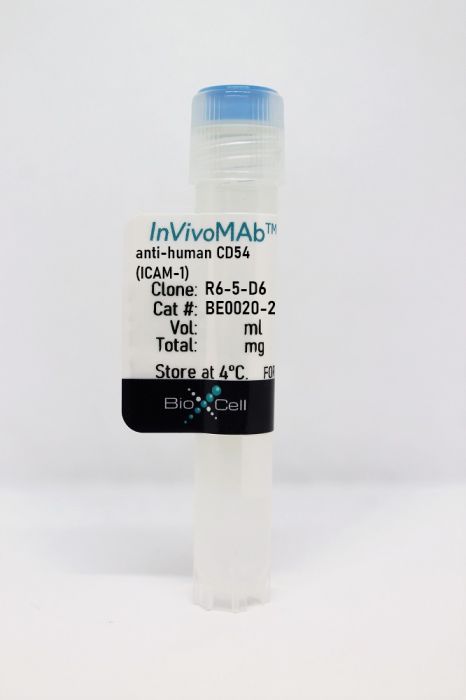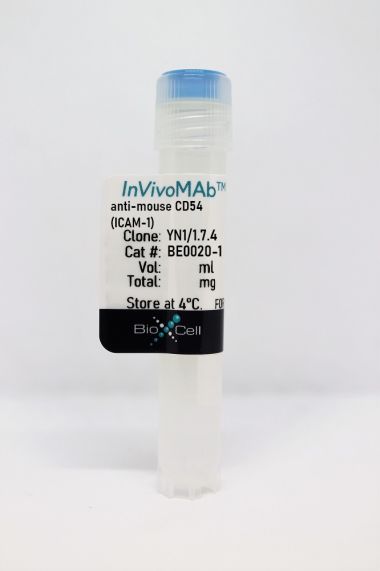InVivoMAb anti-human CD54 (ICAM-1)
Product Details
The R6-5-D6 monoclonal antibody reacts with human CD54 also known as Intercellular Adhesion Molecule-1 (ICAM-1), is a single-chain transmembrane glycoprotein with a polypeptide core of 55 kDa and a member of the Ig superfamily. CD54 is typically expressed on non-hematopoietic cells such as endothelial cells, thymic epithelial cells, and fibroblasts but can also be expressed on macrophages, T-lymphoblasts, germinal center B cells and dendritic cells. CD54 is a ligand for LFA-1, a receptor found on leukocytes. When activated, leukocytes bind to endothelial cells via CD54/LFA-1 and then transmigrate into tissues. Pro-inflammatory cytokines such as IL-1, TNF and IFNγ induce CD54 expression on endothelial cells and fibroblasts. The R6-5-D6 antibody has been reported to inhibit the interaction of CD54 with leukocytes, thereby decreasing leukocyte adhesion to the vascular endothelium and inflammatory tissue injury.Specifications
| Isotype | Mouse IgG2a |
|---|---|
| Recommended Isotype Control(s) | InVivoMAb mouse IgG2a isotype control, unknown specificity |
| Recommended Dilution Buffer | InVivoPure pH 7.0 Dilution Buffer |
| Conjugation | This product is unconjugated. Conjugation is available via our Antibody Conjugation Services. |
| Immunogen | EBV transformed lymphoblast cell line |
| Reported Applications |
in vitro T cell stimulation/activation Immunofluorescence |
| Formulation |
PBS, pH 7.0 Contains no stabilizers or preservatives |
| Endotoxin |
<2EU/mg (<0.002EU/μg) Determined by LAL gel clotting assay |
| Purity |
>95% Determined by SDS-PAGE |
| Sterility | 0.2 µm filtration |
| Production | Purified from cell culture supernatant in an animal-free facility |
| Purification | Protein G |
| RRID | AB_1107659 |
| Molecular Weight | 150 kDa |
| Storage | The antibody solution should be stored at the stock concentration at 4°C. Do not freeze. |
Recommended Products
Immunofluorescence
Vestweber, D., et al. (2013). "Cortactin regulates the activity of small GTPases and ICAM-1 clustering in endothelium: Implications for the formation of docking structures" Tissue Barriers 1(1): e23862. PubMed
Cortactin is an actin-binding molecule that regulates various cellular processes requiring actin dynamics. We recently described cortactin-deficient mice and despite its pivotal role for actin remodeling in vitro, these mice are surprisingly healthy. Analyzing cortactin functions in endothelium under inflammatory conditions, we found that cortactin is required for endothelial barrier functions and leukocyte extravasation in vivo. Importantly, these effects were not regulated by defective actin dynamics but instead by a failure to activate the small GTPases Rap1 and RhoG in endothelial cells. Defective RhoG signaling led to reduced ICAM-1 clustering that supported the interaction with leukocytes. These clusters originally seen as rings surrounding adherent leukocytes actually represented in many cases ICAM-1 containing protrusions as they were described before as docking structures. Thus, cortactin is essential for the formation of endothelial docking structures as well as for leukocyte adhesion and extravasation.
in vitro T cell stimulation/activation
Williams, K. M., et al. (2011). "Choice of resident costimulatory molecule can influence cell fate in human naive CD4+ T cell differentiation" Cell Immunol 271(2): 418-427. PubMed
With antigen stimulation, naive CD4+ T cells differentiate to several effector or memory cell populations, and cytokines contribute to differentiation outcome. Several proteins on these cells receive costimulatory signals, but a systematic comparison of their differential effects on naive T cell differentiation has not been conducted. Two costimulatory proteins, CD28 and ICAM-1, resident on human naive CD4+ T cells were compared for participation in differentiation. Under controlled conditions, and with no added cytokines, costimulation through either CD3+CD28 or CD3+CAM-1 induced differentiation to T effector and T memory cells. In contrast, costimulation through CD3+ICAM-1 induced differentiation to Treg cells whereas costimulation through CD3+CD28 did not.
Immunofluorescence
Schnoor, M., et al. (2011). "Cortactin deficiency is associated with reduced neutrophil recruitment but increased vascular permeability in vivo" J Exp Med 208(8): 1721-1735. PubMed
Neutrophil extravasation and the regulation of vascular permeability require dynamic actin rearrangements in the endothelium. In this study, we analyzed in vivo whether these processes require the function of the actin nucleation-promoting factor cortactin. Basal vascular permeability for high molecular weight substances was enhanced in cortactin-deficient mice. Despite this leakiness, neutrophil extravasation in the tumor necrosis factor-stimulated cremaster was inhibited by the loss of cortactin. The permeability defect was caused by reduced levels of activated Rap1 (Ras-related protein 1) in endothelial cells and could be rescued by activating Rap1 via the guanosine triphosphatase (GTPase) exchange factor EPAC (exchange protein directly activated by cAMP). The defect in neutrophil extravasation was caused by enhanced rolling velocity and reduced adhesion in postcapillary venules. Impaired rolling interactions were linked to contributions of beta(2)-integrin ligands, and firm adhesion was compromised by reduced ICAM-1 (intercellular adhesion molecule 1) clustering around neutrophils. A signaling process known to be critical for the formation of ICAM-1-enriched contact areas and for transendothelial migration, the ICAM-1-mediated activation of the GTPase RhoG was blocked in cortactin-deficient endothelial cells. Our results represent the first physiological evidence that cortactin is crucial for orchestrating the molecular events leading to proper endothelial barrier function and leukocyte recruitment in vivo.
- Immunology and Microbiology,
- Neuroscience
Segmental flexibility of bispecific T-cell engagers regulates the dynamics of immune synapse formation
Preprint on BioRxiv : the Preprint Server for Biology on 17 June 2022 by Staufer, O., Leithner, A., et al.
PubMed
Bispecific T-cell engagers (TcEs) are antibody-based immunotherapeutic drugs that specifically direct lymphocyte effector functions against tumors. TcEs have one arm with affinity for an activating immunoreceptor connected through a flexible hinge to a distinct arm with affinity for a tumor antigen to achieve tumor killing by cytotoxic immune cells. Understanding the structure-function relationships between TcE architecture, immunological synapse formation and function could accelerate design of new TcE-based cancer therapies. Here, we engineer and systematically characterize TcE formats with antigen binding antibody fragments or single chain variable fragments linked together in cis through immunoglobulin G1 hinge or in trans across the antibody constant fragment. The TcEs were tested in CD8 + T-cell killing of Her2 + breast cancer cells and evaluated by high-content imaging of immunological synapse formation on a supported lipid bilayer (SLB) platform. We find that cis TcEs perform better than a trans TcE for T-cell mediated killing. Quantification of synapse formation dynamics revealed that all three cis TcEs tested, created close contacts of 16 nm leading to rapid synapse formation and integrin activation. In contrast, the trans TcE formed close contacts averaging ≥ 16 nm and formed synapses more slowly with weaker integrin activation. We conclude that segmental flexibility is important for TcE function, but adding additional degrees of freedom through trans formats has a cost for killing efficiency that may be explained by failure of close contact formation and integrin activation.
- FC/FACS,
- Homo sapiens (Human),
- Cancer Research
Development and characterization of CD54-targeted immunoPET imaging in solid tumors.
In European Journal of Nuclear Medicine and Molecular Imaging on 1 November 2020 by Wei, W., Jiang, D., et al.
PubMed
Intercellular adhesion molecule-1 (ICAM-1, CD54) is an emerging therapeutic target for a variety of solid tumors including melanoma and anaplastic thyroid cancer (ATC). This study aims to develop an ICAM-1-targeted immuno-positron emission tomography (immunoPET) imaging strategy and assess its diagnostic value in melanoma and ATC models. Flow cytometry was used to screen ICAM-1-positive melanoma and ATC cell lines. Melanoma and ATC models were established using A375 cell line and THJ-16T cell line, respectively. An ICAM-1-specific monoclonal antibody (R6-5-D6) and a nonspecific human IgG were radiolabeled with 64Cu and the diagnostic efficacies were interrogated in tumor-bearing mouse models. Biodistribution and fluorescent imaging studies were performed to confirm the specificity of the ICAM-1-targeted imaging probes. ICAM-1 was strongly expressed on melanoma and advanced thyroid cancer cell lines. 64Cu-NOTA-ICAM-1 immunoPET imaging efficiently delineated A375 melanomas with a peak tumor uptake of 21.28 ± 6.56 %ID/g (n = 5), significantly higher than that of 64Cu-NOTA-IgG (10.63 ± 2.58 %ID/g, n = 3). Moreover, immunoPET imaging with 64Cu-NOTA-ICAM-1 efficiently visualized subcutaneous and orthotopic ATCs with high clarity and contrast. Fluorescent imaging with IRDye 800CW-ICAM-1 also visualized orthotopic ATCs and the tumor uptake could be blocked by the ICAM-1 parental antibody R6-5-D6, indicating the high specificity of the developed probe. Finally, blocking with the human IgG prolonged the circulation of the 64Cu-NOTA-ICAM-1 in R2G2 mice without compromising the tumor uptake. ICAM-1-targeted immunoPET imaging could characterize ICAM-1 expression in melanoma and ATC, which holds promise for optimizing ICAM-1-targeted therapies in the future.
- Block,
- Homo sapiens (Human),
- Cancer Research,
- Immunology and Microbiology
Defective Localization With Impaired Tumor Cytotoxicity Contributes to the Immune Escape of NK Cells in Pancreatic Cancer Patients.
In Frontiers in Immunology on 27 April 2019 by Lim, S. A., Kim, J., et al.
PubMed
Tumor-infiltrating lymphocytes (TILs), found in patients with advanced pancreatic ductal adenocarcinoma (PDAC), are shown to correlate with overall survival (OS) rate. Although majority of TILs consist of CD8+/CD4+ T cells, the presence of NK cells and their role in the pathogenesis of PDAC remains elusive. We performed comprehensive analyses of TIL, PBMC, and autologous tumor cells from 80 enrolled resectable PDAC patients to comprehend the NK cell defects within PDAC. Extremely low frequencies of NK cells (0.5%) were found within PDAC tumors, which was attributable not to the low expression of tumor chemokines, but to the lack of chemokine receptor, CXCR2. Forced expression of CXCR2 in patients' NK cells rendered them capable of trafficking into PDAC. Furthermore, NK cells exhibited impaired cell-mediated killing of autologous PDAC cells, primarily due to insufficient ligation of NKG2D and DNAM-1, and failed to proliferate within the hypoxic tumor microenvironment. Importantly, these defects could be overcome by ex-vivo stimulation of NK cells from such patients. Importantly, when the proliferative capacity of NK cells in vitro was used to stratify patients on the basis of cell expansion, patients whose NK cells proliferated 250-fold experienced significantly lower DFS and OS than those with ≥250-fold. Ex-vivo activation of NK cells restored tumor trafficking and reactivity, hence provided a therapeutic modality while their fold expansion could be a potentially significant prognostic indicator of OS and DFS in such patients.




